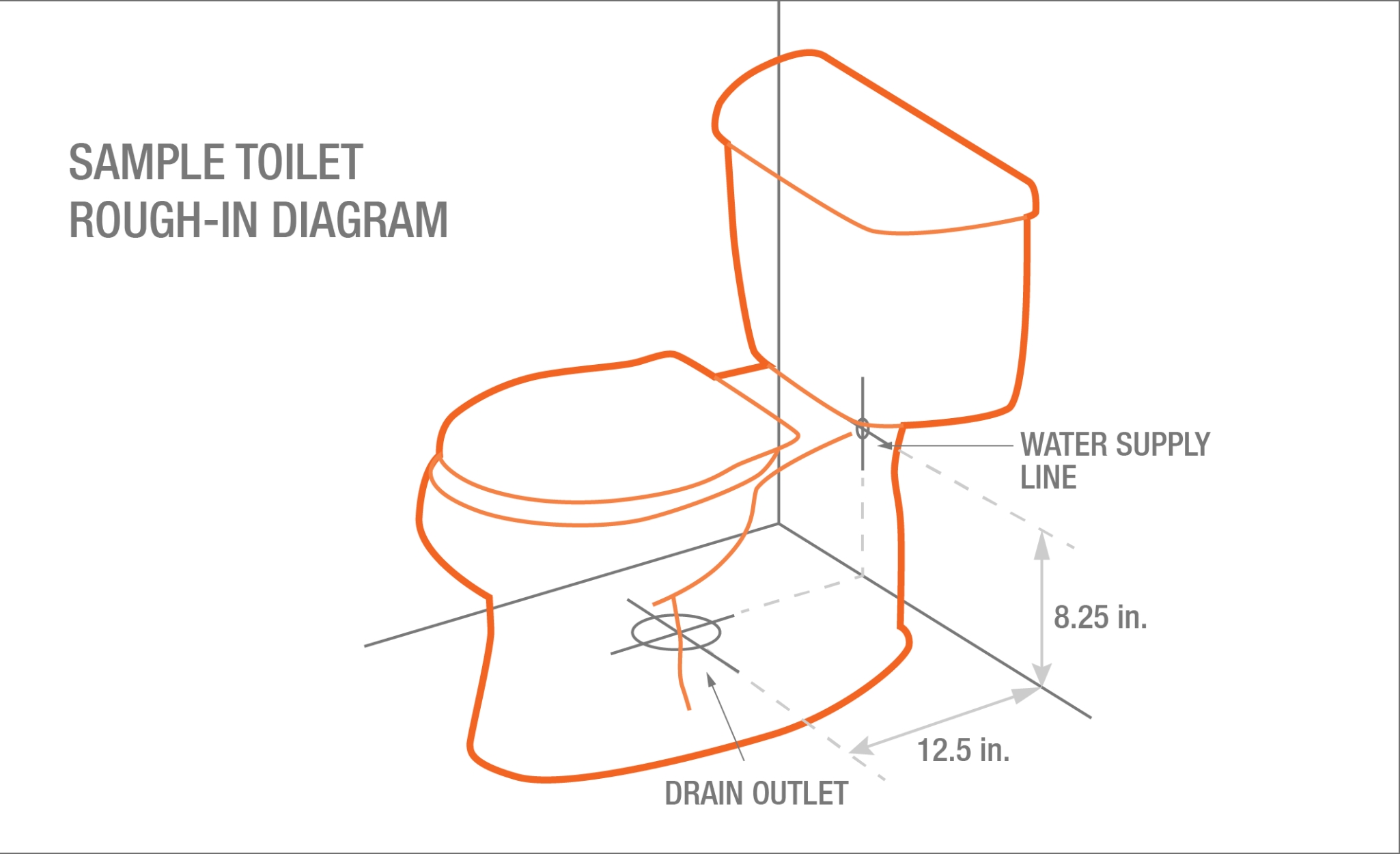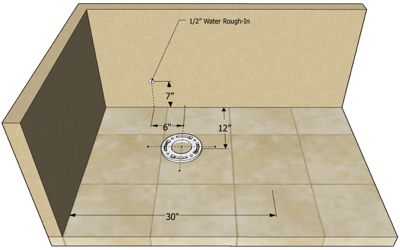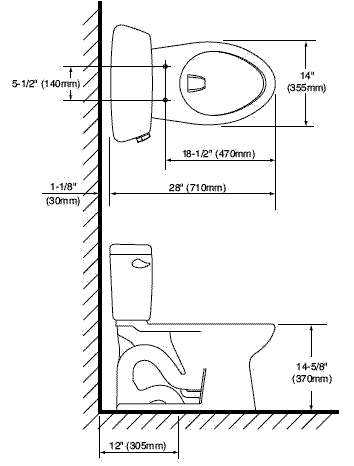Disclosure: This post contains affiliate links and I will be compensated if you make a purchase after clicking through my links. Learn More
The toilet drain distance from the wall is usually 12 inches. It can vary, though, from 10 to 14 inches.
Understanding the correct distance is crucial for a proper toilet installation. This measurement, often called the “rough-in,” ensures your toilet fits perfectly and works efficiently. Incorrect placement can lead to plumbing issues and costly repairs. Whether you are renovating your bathroom or installing a new toilet, knowing this distance is vital.
It helps avoid mistakes and ensures a smooth installation process. In this blog post, we will explore the standard measurements, why they matter, and tips for getting it right. Let’s dive into the details and make sure your toilet installation is flawless.
Standard Toilet Drain Distance
Understanding the standard toilet drain distance is crucial for bathroom installations. This distance affects the placement of the toilet and its overall functionality. Most toilets have a specific measurement that needs to be followed.
This measurement ensures that the toilet fits well and operates efficiently. Let’s dive into the standard distances and why they are important.
Common Measurements
The most common measurement for toilet drain distance is 12 inches. This means the center of the toilet flange is 12 inches from the wall. Other standard distances include 10 inches and 14 inches. Review 10-inch vs 12-inch rough-in options.
These measurements cater to different types of bathrooms. Smaller spaces might use a 10-inch measurement, while larger bathrooms might need 14 inches.
Why Distance Matters
Correct toilet drain distance ensures proper installation. An incorrect measurement can lead to leaks and other issues. It also affects the comfort and usability of the toilet.
Proper distance allows for easy cleaning and maintenance. It ensures that the toilet aligns well with the plumbing system.
Factors Influencing Drain Placement
Understanding the factors influencing toilet drain placement can help with bathroom renovations. Various elements affect where the drain is located.
Bathroom Layout
The layout of your bathroom significantly impacts drain placement. The position of walls, doors, and fixtures plays a role. For example, a compact bathroom might require creative plumbing solutions. The available space dictates where the drain can go. Ensuring enough room for the toilet and other fixtures is crucial.
Plumbing Codes
Plumbing codes are essential in determining drain placement. These regulations ensure safe and functional plumbing systems. Local building codes may specify minimum distances from the wall. These codes prevent plumbing issues and ensure proper drainage. Always check local codes before starting any plumbing work.
Tools To Measure Drain Distance
Measuring the toilet drain distance is essential for proper installation. Use a measuring tape to find the distance from the wall to the center of the drainpipe. This helps ensure the toilet fits correctly in your bathroom space.
When planning bathroom renovations or installations, one crucial aspect to consider is the distance of the toilet drain from the wall. Accurately measuring this distance ensures a smooth installation and avoids potential plumbing issues. Using the right tools can make the process straightforward and precise. Let’s dive into some practical tools you can use to measure this distance effectively.
Tape Measure Basics
A tape measure is a simple yet essential tool for measuring the distance of a toilet drain from the wall. It’s something you likely have in your toolbox already. You can use it to get a quick and accurate measurement.
To measure, extend the tape measure from the center of the toilet drain to the wall behind it. Make sure the tape is straight and taut. This will give you the rough-in measurement, which is usually between 10 to 14 inches for most toilets.
Have you ever found yourself frustrated because the tape wouldn’t stay in place? Try using a small piece of painter’s tape to hold the tape measure in place on the floor. It frees up your hands and helps ensure accuracy.
Laser Measuring Devices
If you’re looking for precision, laser measuring devices are an excellent choice. They are easy to use and provide highly accurate measurements, often to the millimeter.
To use a laser measure, place it at the center of the toilet drain and aim the laser beam at the wall. The device will calculate the distance and display it on the screen. This tool is especially useful in tight spaces where a tape measure might be cumbersome.
Have you ever wondered how professionals get such precise measurements? Many rely on laser devices for speed and accuracy. They are a worthy investment if you’re planning multiple renovations or need exact measurements for custom fittings.
Using the right tools not only makes the task easier but also ensures your bathroom project goes off without a hitch. Which tool would you prefer to use for your next project?
Installation Variations
Toilet installation can vary greatly. Understanding these variations helps in achieving the right fit. The distance from the wall to the toilet drain impacts your bathroom’s layout. This distance influences the choice of toilet and design. Knowing these variations saves time and resources during installation.
Different Toilet Types
Toilets come in various types. Each type has its own installation requirements. Standard toilets often have a 12-inch rough-in. Compact toilets might need less space. Wall-hung toilets offer flexibility. They can have adjustable distances from the wall. Corner toilets fit uniquely in small spaces. Their installation differs from standard ones.
Unique Bathroom Designs
Every bathroom design is unique. This uniqueness affects toilet installation. Small bathrooms might need specialized toilets. Large bathrooms offer more freedom in layout. Modern designs often include wall-mounted toilets. These require different installation techniques. Vintage bathrooms may have older plumbing systems. This impacts the choice of toilet.
Troubleshooting Drain Issues
Toilet drain issues can be frustrating. A common problem is improper distance from the wall. This can lead to various drainage problems. Understanding how far the toilet drain should be is crucial. This section will explore typical problems and offer solutions.
Common Problems
A toilet drain too close to the wall may cause clogs. It can also lead to leaks. This happens when the drain is misaligned. The toilet may wobble or be difficult to install properly. These issues can waste water and cause damage.
Solutions And Tips
Check the rough-in measurement. Standard rough-in is 12 inches from the wall. Adjust the toilet placement if needed. Use a wax ring to seal the toilet base. This prevents leaks. Ensure the toilet is level and stable. Tighten bolts securely. Regularly check for leaks. Maintain the plumbing system to avoid future problems.

Credit: www.homedepot.com
Diy Drain Adjustments
Adjusting the toilet drain can save you time and money. It’s a practical task many homeowners can tackle. Understanding how far the toilet drain is from the wall is essential. DIY drain adjustments can be simple with the right guidance. Below, find out how you can adjust the drain yourself.
Materials Needed
Step-by-step Guide
- Measure the distance from the wall to the drain. This helps determine the needed adjustment.
- Turn off the water supply. This prevents any leaks or spills during the process.
- Remove the toilet by unscrewing the bolts. Carefully lift and set it aside.
- Inspect the flange. If damaged, replace it with a new one.
- Use the pipe cutter to trim the drain pipe if necessary. Ensure it aligns correctly with the flange.
- Apply plumber’s putty around the flange. This ensures a tight seal when the toilet is reinstalled.
- Reattach the toilet, securing it with bolts. Make sure it sits evenly on the floor.
- Turn the water supply back on. Check for any leaks around the base.
Hiring A Professional
Hiring a professional to install or adjust your toilet can save time and stress. It ensures the toilet drain aligns correctly with the wall. Professionals have the tools and knowledge for precise measurements. They understand building codes and plumbing standards. A small error can lead to costly repairs and water damage. Getting it right the first time is crucial.
When To Call An Expert
Call an expert if you notice leaks or instability. Poor installation can cause these issues. They can identify problems quickly. If your toilet rocks or shifts, it needs attention. Experts fix these problems efficiently. If you’re unsure about measurements, seek help. Wrong calculations can lead to installation errors.
Cost Considerations
The cost of hiring a plumber varies. It depends on the complexity of the job. Simple adjustments may cost less. Major installations might be pricier. Consider the long-term benefits. Professional installation prevents future issues. It can save money over time. Compare quotes before deciding. Choose a reputable service.

Credit: www.hammerpedia.com
Future-proofing Your Bathroom
Planning a bathroom upgrade? Knowing the toilet drain’s distance from the wall is crucial. Typically, this distance measures about 12 inches. Ensuring accurate measurements helps future-proof your bathroom, allowing for smooth installations and avoiding costly mistakes.
Future-proofing your bathroom is all about making smart choices today that will save you time, money, and headaches tomorrow. One of the most overlooked aspects of bathroom design is the placement of the toilet drain. While it might seem trivial, ensuring the correct distance of the toilet drain from the wall can have a significant impact on your bathroom’s adaptability to future changes.
Imagine planning a bathroom renovation only to find out that your toilet placement limits your design options. By considering the right measurements now, you can enjoy a flexible and efficient bathroom for years to come.
Planning For Renovations
When you think about future-proofing, consider the possibility of renovations down the road. You may want to upgrade to a more modern toilet model or change your bathroom layout entirely.
To avoid costly adjustments later, ensure that the toilet drain is positioned with standard measurements in mind. Typically, a 12-inch rough-in is standard, but you might encounter 10 or 14 inches too. Measure and plan for these variations now to give yourself more options later.
If you’ve ever been caught in a renovation nightmare, you know the importance of planning. A little foresight now can save you from tearing up floors or knocking down walls later.
Flexible Design Options
Having a flexible design is key to accommodating your evolving tastes and needs. A toilet drain that’s too close to the wall can limit your choices when it comes to selecting new fixtures or redesigning your bathroom space.
Consider opting for wall-mounted toilets or floating vanities to create more space. This approach not only provides a sleek, modern look but also makes cleaning easier and allows for changes without major plumbing overhauls.
You might not be thinking of a change now, but what about in five years? Keeping your design flexible ensures that you’re not boxed into a corner. Wouldn’t it be great to refresh your bathroom with minimal hassle?
Evaluate the layout of your bathroom to ensure it can accommodate different styles and setups. By doing so, you’re not just designing for today, but for tomorrow’s possibilities as well.
In conclusion, taking the time to future-proof your bathroom by considering the placement of your toilet drain is a smart investment. It will help you avoid costly renovations and give you the flexibility to adapt to new trends and needs effortlessly.

Credit: terrylove.com
Frequently Asked Questions
How Far Should A Toilet Drain Be From The Wall?
The toilet drain should be 12 inches from the finished wall. This measurement ensures proper installation and function.
How Far Off The Wall Is A Toilet Waste?
The toilet waste pipe is typically 12 inches from the wall. This distance is standard for most installations.
How Much Clearance Does A Toilet Need From The Wall?
A toilet needs at least 15 inches of clearance from the center to the wall. This ensures comfortable use. Always check local building codes for specific requirements.
What Is The Code For A Toilet From The Wall?
The toilet code from the wall typically refers to plumbing specifications. Standard distance is 12 inches from the wall to the toilet’s waste pipe. Check local building codes for exact requirements, as they may vary by region. Always consult a professional plumber for precise installation guidelines.
Final Words
Understanding the toilet drain distance from the wall is crucial. This measurement ensures a proper fit. It helps avoid plumbing issues. Standard distance is typically 12 inches. Measure carefully before installation. Accurate measurements lead to a better bathroom setup. A well-planned installation saves time.
It also prevents costly mistakes. Keep these tips in mind. Your bathroom renovation will go smoothly. Always check the specifications. Follow guidelines for best results. Happy remodeling!


